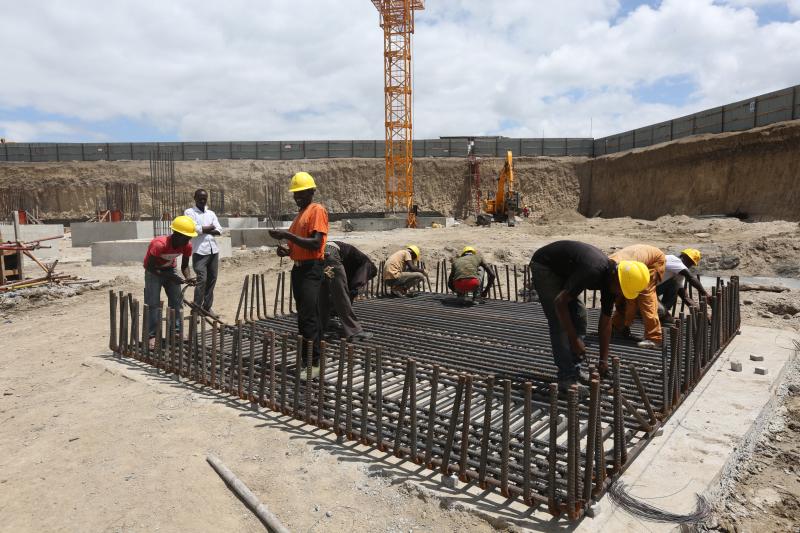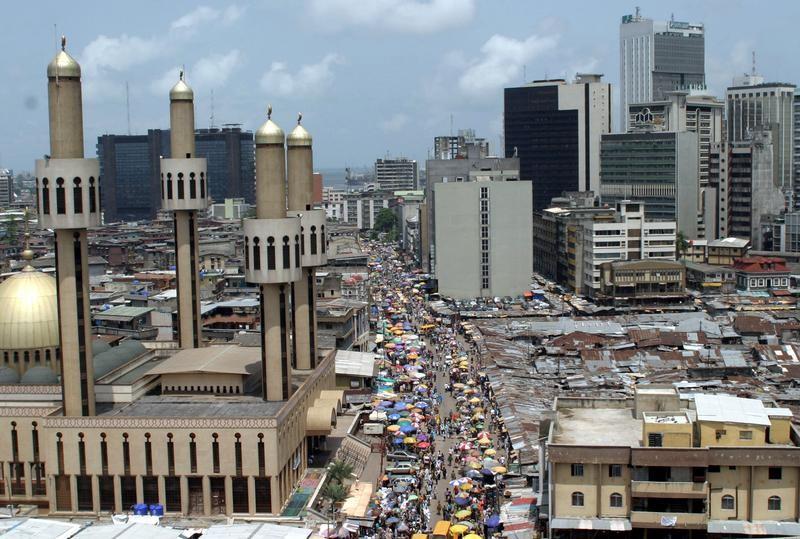
Workers lay the foundations of a building at Konza City in November 2016. Kenya’s smart city is yet to take shape after years of construction and marketing. [File, Standard]
By 2050 an estimated 2.5 billion more people will be added to urban areas, with 90 per cent of this growth taking place in Africa and Asia.
According to Nobel Prize-winning economist Paul Romer, this will mean the building of more urban areas in the next 100 years than currently exist today.
If managed effectively, Africa’s cities will drive the continent’s economic growth, and thereby help reduce poverty.
To date, however, Africa has yet to realise the positive gains of rapid urbanisation experienced elsewhere.
Instead, increasingly concentrated populations have become major stress on the limited infrastructure and services such as housing, employment, health, education and safety.
Retrofitting cities, where cities already exist, can be up to three times more expensive than planning for infrastructure in advance of settlement.
Therefore, some leaders see the construction of whole new cities as the overall solution to overcome the pressures on existing ones.
The idea of constructing new cities to solve urbanisation challenges is not new. In Africa, for example, the first post-independence wave came with some governments deciding to move their capital cities.
The motivations for this varied. In the case of Yamoussoukro, which was declared the capital of Côte d’Ivoire in 1983, the move reflected the desire of the then-president Houphouët-Boigny to have the capital located in his home town.
In Nigeria, on the other hand, Abuja became the new capital in 1991 to relieve population pressures in Lagos. The choice of the site for Abuja was motivated by the fact that it was located in the centre of the country.

People and traffic move along a busy street in Lagos, Nigeria, May 24, 2005. [George Esiri, Reuters]
It is also more ethnically neutral as it was located between the country’s northern, majority Muslim population and southern, largely Christian population.
The creation of the city of Abuja, therefore, was also to help bridge the divisions in the country in terms of politics as well as an economic opportunity.
The fortunes of Yamoussoukro and Abuja offer important lessons for current planners of new cities – 120 are being built in 40 countries.
Although some people were attracted to Yamoussoukro by the prospect of a newly constructed international airport, and even the world’s largest church, most stayed away.
While it continues to be the country’s administrative capital, most government institutions remain in Abidjan.
On top of this, Abidjan is still a vastly more popular city. It is the economic hub of the country, with an estimated population of close to four million.
Yamoussoukro’s population is approximately 200,000, making it only the sixth-largest city in the country.
Any new city takes time to grow. Abuja, though still much smaller than Lagos - which remains Nigeria’s economic hub - has, however, already experienced rapid population growth since it was founded.
In 1987 its population was only about 15,000 people. Today, it has a population of over three million.
The current wave of new city building is largely focused on leap-frogging economic development and moving Africa’s cities directly into the age of futuristic, technologically advanced, so-called ‘smart cities’.
Plans for these types of cities are sprouting up across the continent; from Kenya, Mauritius and Senegal.
Leading the way is Nigeria with five current on-going new city projects, which, when completed, are set to cover a landmass of 25 million square metres.
The agenda of new city building is not only being pushed by governments, but by a vast array of construction, real estate and technology companies, who stand to profit from the city construction boom, as well.
Yet these new cities will want to avoid pitfalls of places like Cyberjaya, Malaysia. Cyberjaya was the Malaysian government’s attempt to emulate Silicon Valley and pioneer such a hub in Asia.

A general view of Penang skyline, Malaysia, September 20, 2019. [Lim Huey Teng, Reuters]
Cyberjaya was built on 2,800 hectares of undeveloped land, 40km south of Kuala Lumpur. The idea behind the city was to create a space where intelligent minds from across the globe could reside comfortably and just concentrate on innovation.
Malaysia hoped that its first-mover advantage in the smart city arena would attract investors. They also believed that Cyberjaya could be a model for the city of the future.
Yet Cyberjaya has failed to live up to its reputation. In particular, a fundamental design flaw was the lack of understanding that people move to cities not only for the infrastructure but also the amenities, as well as to build networks and to integrate into existing networks.
In conceptualising Cyberjaya, the Malaysian government largely ignored this.
Rather the city was envisaged only for the highly educated elite, who, it was assumed, did not require many further amenities outside a suitable work environment.
As a result of the failure to understand the human aspect of cities, many parts of Cyberjaya have remained vacant to date.
Many of Africa’s upcoming “smart cities” exhibit similar conceptualisation flaws.
Pay off
Senegal’s futuristic city Diamniadio, a core part of President Macky Sall’s 2035 plan, is meant to be a “city of knowledge”. It will comprise an industrial park with entertainment facilities and residential areas.
However, when the city is completed, which is intended to be by 2035, it is unlikely that the majority of Senegalese will be able to afford to live there.
An estimated $100 billion (Sh10 trillion) is being invested in new city projects across Africa.
The assumption is that these investments will pay off. The logic is that these cities will attract the best and the brightest.
In turn, this should drive productivity increases that ultimately will repay the large loans.
But failure invariably comes with large debt bills that African countries cannot afford, and may leave large, unfinished ghost cities in its wake.




No comments :
Post a Comment